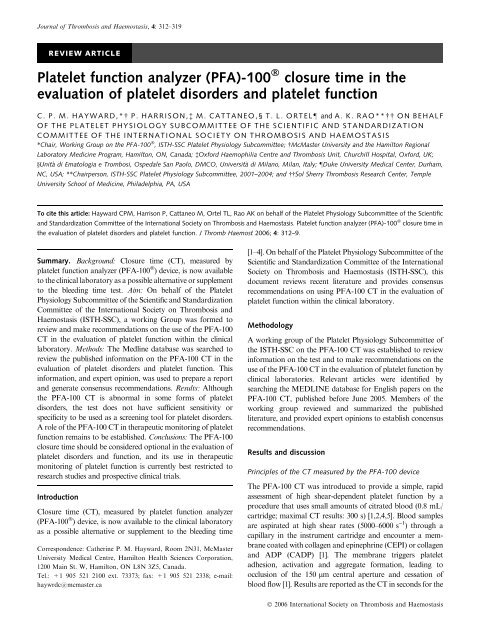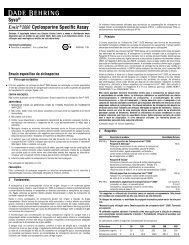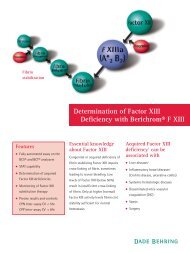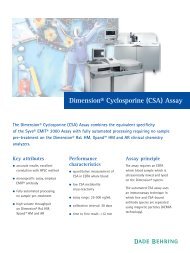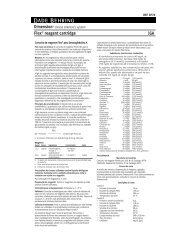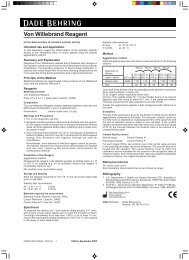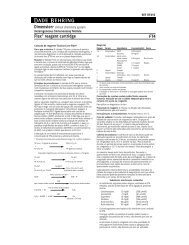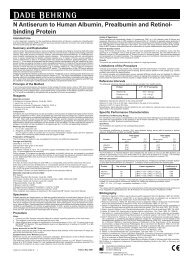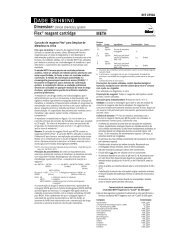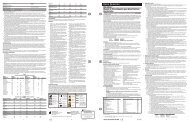(PFA)-100® closure time in the evaluation of platelet ... - Medcorp
(PFA)-100® closure time in the evaluation of platelet ... - Medcorp
(PFA)-100® closure time in the evaluation of platelet ... - Medcorp
Create successful ePaper yourself
Turn your PDF publications into a flip-book with our unique Google optimized e-Paper software.
Journal <strong>of</strong> Thrombosis and Haemostasis, 4: 312–319REVIEW ARTICLEPlatelet function analyzer (<strong>PFA</strong>)-100 Ò <strong>closure</strong> <strong>time</strong> <strong>in</strong> <strong>the</strong><strong>evaluation</strong> <strong>of</strong> <strong>platelet</strong> disorders and <strong>platelet</strong> functionC. P. M. HAYWARD,* P. HARRISON,à M.CATTANEO,§T.L.ORTEL– and A. K. RAO** ON BEHALFOF THE PLATELET PHYSIOLOGY SUBCOMMITTEE OF THE SCIENTIFIC AND STANDARDIZATIONCOMMITTEE OF THE INTERNATIONAL SOCIETY ON THROMBOSIS AND HAEMOSTASIS*Chair, Work<strong>in</strong>g Group on <strong>the</strong> <strong>PFA</strong>-100 Ò , ISTH-SSC Platelet Physiology Subcommittee; McMaster University and <strong>the</strong> Hamilton RegionalLaboratory Medic<strong>in</strong>e Program, Hamilton, ON, Canada; àOxford Haemophilia Centre and Thrombosis Unit, Churchill Hospital, Oxford, UK;§Unità di Ematologia e Trombosi, Ospedale San Paolo, DMCO, Università di Milano, Milan, Italy; –Duke University Medical Center, Durham,NC, USA; **Chairperson, ISTH-SSC Platelet Physiology Subcommittee, 2001–2004; and Sol Sherry Thrombosis Research Center, TempleUniversity School <strong>of</strong> Medic<strong>in</strong>e, Philadelphia, PA, USATo cite this article: Hayward CPM, Harrison P, Cattaneo M, Ortel TL, Rao AK on behalf <strong>of</strong> <strong>the</strong> Platelet Physiology Subcommittee <strong>of</strong> <strong>the</strong> Scientificand Standardization Committee <strong>of</strong> <strong>the</strong> International Society on Thrombosis and Haemostasis. Platelet function analyzer (<strong>PFA</strong>)-100 Ò <strong>closure</strong> <strong>time</strong> <strong>in</strong><strong>the</strong> <strong>evaluation</strong> <strong>of</strong> <strong>platelet</strong> disorders and <strong>platelet</strong> function. J Thromb Haemost 2006; 4: 312–9.Summary. Background: Closure <strong>time</strong> (CT), measured by<strong>platelet</strong> function analyzer (<strong>PFA</strong>-100 Ò ) device, is now availableto <strong>the</strong> cl<strong>in</strong>ical laboratory as a possible alternative or supplementto <strong>the</strong> bleed<strong>in</strong>g <strong>time</strong> test. Aim: On behalf <strong>of</strong> <strong>the</strong> PlateletPhysiology Subcommittee <strong>of</strong> <strong>the</strong> Scientific and StandardizationCommittee <strong>of</strong> <strong>the</strong> International Society on Thrombosis andHaemostasis (ISTH-SSC), a work<strong>in</strong>g Group was formed toreview and make recommendations on <strong>the</strong> use <strong>of</strong> <strong>the</strong> <strong>PFA</strong>-100CT <strong>in</strong> <strong>the</strong> <strong>evaluation</strong> <strong>of</strong> <strong>platelet</strong> function with<strong>in</strong> <strong>the</strong> cl<strong>in</strong>icallaboratory. Methods: The Medl<strong>in</strong>e database was searched toreview <strong>the</strong> published <strong>in</strong>formation on <strong>the</strong> <strong>PFA</strong>-100 CT <strong>in</strong> <strong>the</strong><strong>evaluation</strong> <strong>of</strong> <strong>platelet</strong> disorders and <strong>platelet</strong> function. This<strong>in</strong>formation, and expert op<strong>in</strong>ion, was used to prepare a reportand generate consensus recommendations. Results: Although<strong>the</strong> <strong>PFA</strong>-100 CT is abnormal <strong>in</strong> some forms <strong>of</strong> <strong>platelet</strong>disorders, <strong>the</strong> test does not have sufficient sensitivity orspecificity to be used as a screen<strong>in</strong>g tool for <strong>platelet</strong> disorders.A role <strong>of</strong> <strong>the</strong> <strong>PFA</strong>-100 CT <strong>in</strong> <strong>the</strong>rapeutic monitor<strong>in</strong>g <strong>of</strong> <strong>platelet</strong>function rema<strong>in</strong>s to be established. Conclusions: The <strong>PFA</strong>-100<strong>closure</strong> <strong>time</strong> should be considered optional <strong>in</strong> <strong>the</strong> <strong>evaluation</strong> <strong>of</strong><strong>platelet</strong> disorders and function, and its use <strong>in</strong> <strong>the</strong>rapeuticmonitor<strong>in</strong>g <strong>of</strong> <strong>platelet</strong> function is currently best restricted toresearch studies and prospective cl<strong>in</strong>ical trials.IntroductionClosure <strong>time</strong> (CT), measured by <strong>platelet</strong> function analyzer(<strong>PFA</strong>-100 Ò ) device, is now available to <strong>the</strong> cl<strong>in</strong>ical laboratoryas a possible alternative or supplement to <strong>the</strong> bleed<strong>in</strong>g <strong>time</strong>Correspondence: Ca<strong>the</strong>r<strong>in</strong>e P. M. Hayward, Room 2N31, McMasterUniversity Medical Centre, Hamilton Health Sciences Corporation,1200 Ma<strong>in</strong> St. W, Hamilton, ON L8N 3Z5, Canada.Tel.: +1 905 521 2100 ext. 73373; fax: +1 905 521 2338; e-mail:haywrdc@mcmaster.ca[1–4]. On behalf <strong>of</strong> <strong>the</strong> Platelet Physiology Subcommittee <strong>of</strong> <strong>the</strong>Scientific and Standardization Committee <strong>of</strong> <strong>the</strong> InternationalSociety on Thrombosis and Haemostasis (ISTH-SSC), thisdocument reviews recent literature and provides consensusrecommendations on us<strong>in</strong>g <strong>PFA</strong>-100 CT <strong>in</strong> <strong>the</strong> <strong>evaluation</strong> <strong>of</strong><strong>platelet</strong> function with<strong>in</strong> <strong>the</strong> cl<strong>in</strong>ical laboratory.MethodologyA work<strong>in</strong>g group <strong>of</strong> <strong>the</strong> Platelet Physiology Subcommittee <strong>of</strong><strong>the</strong> ISTH-SSC on <strong>the</strong> <strong>PFA</strong>-100 CT was established to review<strong>in</strong>formation on <strong>the</strong> test and to make recommendations on <strong>the</strong>use <strong>of</strong> <strong>the</strong> <strong>PFA</strong>-100 CT <strong>in</strong> <strong>the</strong> <strong>evaluation</strong> <strong>of</strong> <strong>platelet</strong> function bycl<strong>in</strong>ical laboratories. Relevant articles were identified bysearch<strong>in</strong>g <strong>the</strong> MEDLINE database for English papers on <strong>the</strong><strong>PFA</strong>-100 CT, published before June 2005. Members <strong>of</strong> <strong>the</strong>work<strong>in</strong>g group reviewed and summarized <strong>the</strong> publishedliterature, and provided expert op<strong>in</strong>ions to establish concensusrecommendations.Results and discussionPr<strong>in</strong>ciples <strong>of</strong> <strong>the</strong> CT measured by <strong>the</strong> <strong>PFA</strong>-100 deviceThe <strong>PFA</strong>-100 CT was <strong>in</strong>troduced to provide a simple, rapidassessment <strong>of</strong> high shear-dependent <strong>platelet</strong> function by aprocedure that uses small amounts <strong>of</strong> citrated blood (0.8 mL/cartridge; maximal CT results: 300 s) [1,2,4,5]. Blood samplesare aspirated at high shear rates (5000–6000 s )1 ) through acapillary <strong>in</strong> <strong>the</strong> <strong>in</strong>strument cartridge and encounter a membranecoated with collagen and ep<strong>in</strong>ephr<strong>in</strong>e (CEPI) or collagenand ADP (CADP) [1]. The membrane triggers <strong>platelet</strong>adhesion, activation and aggregate formation, lead<strong>in</strong>g toocclusion <strong>of</strong> <strong>the</strong> 150 lm central aperture and cessation <strong>of</strong>blood flow [1]. Results are reported as <strong>the</strong> CT <strong>in</strong> seconds for <strong>the</strong>Ó 2006 International Society on Thrombosis and Haemostasis
<strong>PFA</strong>-100 Ò <strong>in</strong> <strong>the</strong> <strong>evaluation</strong> <strong>of</strong> <strong>platelet</strong> disorders and <strong>platelet</strong> function 313CEPI and CADP cartridges, with values >300 s reported asnon-<strong>closure</strong> [1].Variables <strong>in</strong>fluenc<strong>in</strong>g <strong>PFA</strong>-100 CT resultsThe <strong>PFA</strong>-100 CT is highly dependent on von Willebrand factor(VWF) b<strong>in</strong>d<strong>in</strong>g to <strong>the</strong> <strong>platelet</strong> membrane glycoprote<strong>in</strong> (GP)receptors Ib/IX/V and <strong>in</strong>tegr<strong>in</strong> a IIb b 3 (IIb/IIIa) under highshear [1,2,5–9]. CT has higher sensitivity for von Willebranddisease (VWD) compared with <strong>the</strong> bleed<strong>in</strong>g <strong>time</strong>, and CT isabnormal <strong>in</strong> some congenital and acquired <strong>platelet</strong> functiondefects, but is not prolonged by coagulation factor deficiencies(reviewed <strong>in</strong> Harrison [5]) [4,7,10–19]. This review is primarilyfocused on <strong>the</strong> use <strong>of</strong> <strong>PFA</strong>-100 CT for evaluat<strong>in</strong>g <strong>platelet</strong>disorders and <strong>platelet</strong> function.The manufacturer advises that each laboratory shouldestablish its own <strong>PFA</strong>-100 CT reference ranges, us<strong>in</strong>gbuffered 0.109 M (3.2%) or 0.129 M (3.8%) citrate anticoagulatedblood [5,20,21]. Quality control procedures areimportant for test performance, but because <strong>the</strong> test requireswhole blood, <strong>the</strong>re are no provided quality control materials[5]. Coefficients <strong>of</strong> variation range between 6% and 13% forCT with normal samples [8,22,23]. CT are significantly higherfor samples collected <strong>in</strong> 3.8% compared with 3.2% citrate,and 3.8% citrate <strong>in</strong>creases <strong>the</strong> CEPI CT sensitivity to aspir<strong>in</strong>[23,24]. Samples anticoagulated with thromb<strong>in</strong> <strong>in</strong>hibitors (e.g.PPACK) have similar CT to 3.2% or 3.8% citrate anticoagulatedsamples [25]. CT should be determ<strong>in</strong>ed with<strong>in</strong> 4 h<strong>of</strong> sampl<strong>in</strong>g [8,23], and to avoid artefactual results, pneumatictubes should not be used for sample transport [26].Small diurnal variations <strong>in</strong> CT results have been noted, withmorn<strong>in</strong>g samples show<strong>in</strong>g shorter CT, particularly with <strong>the</strong>CEPI cartridge [27]. CT reference ranges for males andfemales are similar although older males may have slightlyshorter CT [28,29]. Children and adults have similar CTvalues whereas neonates have shorter CT because <strong>of</strong> higherhematocrit and VWF levels [30–32].Like <strong>the</strong> bleed<strong>in</strong>g <strong>time</strong>, <strong>the</strong> <strong>PFA</strong>-100 CT is prolonged bysignificant reductions <strong>in</strong> <strong>the</strong> <strong>platelet</strong> count or hematocrit[2,3,8,22,33]. For blood samples conta<strong>in</strong><strong>in</strong>g
314 C. P. M. Hayward et allowÕ, type1Ô<strong>platelet</strong> discordantÕ, type 2A and type 3 VWD,and <strong>the</strong>ir failure to correct with VWF replacement[13,44,45]. In patients with severe aortic stenosis and anacquired VWD characterized by <strong>the</strong> loss <strong>of</strong> <strong>the</strong> largestmul<strong>time</strong>rs, <strong>the</strong> <strong>PFA</strong>-100 CT is prolonged and shortensrapidly after surgery, along with <strong>the</strong> recovery <strong>of</strong> <strong>the</strong> largestmul<strong>time</strong>rs [46]. There is also evidence that higher <strong>platelet</strong>collagen receptor density (a 2 b 1 andtosomeextentGPVI)isassociated with shorter <strong>PFA</strong>-100 CT, especially <strong>in</strong> type 1VWD [9,36,37,47].Consumption <strong>of</strong> flavonoid rich foods (e.g. red w<strong>in</strong>e, cocoaand chocolate) can prolong <strong>the</strong> CEPI CT [48]. O<strong>the</strong>r dietaryeffects (e.g. fish oil consumption) on <strong>the</strong> <strong>PFA</strong>-100 CT have notbeen characterized.<strong>PFA</strong>-100 CT <strong>in</strong> congenital <strong>platelet</strong> disordersIn congenital <strong>platelet</strong> disorders, <strong>the</strong> <strong>PFA</strong>-100 CT varies with<strong>the</strong> severity and nature <strong>of</strong> <strong>the</strong> <strong>platelet</strong> defect (Table 1). Therelatively severe function defects associated with deficiencies ordysfunction <strong>of</strong> <strong>the</strong> <strong>platelet</strong> membrane GP receptors a IIb b 3 (GPIIb/IIIa; Glanzmann thrombas<strong>the</strong>nia) or GP Ib/IX/V (Bernard–Souliersyndrome or <strong>platelet</strong>-type VWD) result <strong>in</strong>markedly prolonged <strong>PFA</strong>-100 CT and typically non-<strong>closure</strong>with CEPI and CADP cartridges [7,8,16,34,49,50]. Plateletmembrane density <strong>of</strong> a 2 b 1 and GP VI <strong>in</strong>fluences <strong>PFA</strong>-100 CT[9,36,47], but <strong>the</strong>re is currently no <strong>in</strong>formation on CT <strong>in</strong> <strong>platelet</strong>a 2 b 1 or GP VI deficiency or dysfunction, because <strong>of</strong> <strong>the</strong> paucity<strong>of</strong> well-characterized patients with defects <strong>in</strong> <strong>the</strong>se prote<strong>in</strong>s.Among <strong>the</strong> more common congenital <strong>platelet</strong> function disorders(<strong>in</strong>clud<strong>in</strong>g dense granule deficiency and conditions withdefective secretion), <strong>PFA</strong>-100 CT f<strong>in</strong>d<strong>in</strong>gs are variable and <strong>the</strong>yare more frequently detected with <strong>the</strong> CEPI cartridge than <strong>the</strong>CADP cartridge (which is <strong>of</strong>ten normal) (Table 1)[4,5,7,8,14,16,34,50–52].There is a need for more <strong>in</strong>formation on <strong>the</strong> <strong>PFA</strong>-100 CT <strong>in</strong>congenital <strong>platelet</strong> disorders as reported studies (summarized <strong>in</strong>Table 1) have evaluated relatively small numbers <strong>of</strong> <strong>in</strong>dividuals(
<strong>PFA</strong>-100 Ò <strong>in</strong> <strong>the</strong> <strong>evaluation</strong> <strong>of</strong> <strong>platelet</strong> disorders and <strong>platelet</strong> function 315Aspir<strong>in</strong> and o<strong>the</strong>r non-steroidal anti-<strong>in</strong>flammatory drugs(NSAIDs) that <strong>in</strong>hibit <strong>platelet</strong> function by block<strong>in</strong>g cyclooxygenase1 (COX-1) and <strong>the</strong>reby thromboxane generationprolong <strong>the</strong> CEPI CT <strong>in</strong> about 95% <strong>of</strong> healthy <strong>in</strong>dividuals, buthave little to no effect on CADP CT [10,49,63] (reviewed <strong>in</strong>[5,64]). Studies <strong>of</strong> patients on aspir<strong>in</strong> <strong>the</strong>rapy for coronary orperipheral vascular arterial disease <strong>in</strong>dicate that only 20–50%have a prolonged CEPI CT [65–68]. Differences <strong>in</strong> reportedCEPI CT sensitivity for aspir<strong>in</strong> may reflect differences <strong>in</strong>populations studied (e.g. healthy controls comparedwith patients with higher VWF levels), aspir<strong>in</strong> dosage andformulation effects [67], and pretest variables, such as <strong>the</strong>citrate concentration used for sample collection [24,69]. It isimportant to recognize that <strong>the</strong> aspir<strong>in</strong>/NSAID pattern <strong>of</strong><strong>PFA</strong>-100 CT abnormalities (CEPI prolonged, CADP normal)is not specific for drug-<strong>in</strong>duced <strong>platelet</strong> dysfunction as similarabnormalities occur with congenital <strong>platelet</strong> disorders (Table 1)[4,8,14,34,50,51,53] and with consumption <strong>of</strong> flavonoid-richfoods [48]. When NSAIDs are discont<strong>in</strong>ued, <strong>PFA</strong>-100 CTabnormalities revert by 6 days with aspir<strong>in</strong> [70] and by 24 hwith ibupr<strong>of</strong>en [71].The <strong>PFA</strong>-100 CT is relatively <strong>in</strong>sensitive to <strong>the</strong>rapy withticlopid<strong>in</strong>e and clopidogrel, with detection <strong>of</strong> effects show<strong>in</strong>g<strong>time</strong> and dose dependence [20,25,57,72–76]. CADP and CEPICT detect synergism <strong>in</strong> <strong>the</strong> anti<strong>platelet</strong> effects <strong>of</strong> clopidogreland aspir<strong>in</strong> [73,74].It has not yet been established if <strong>the</strong> <strong>PFA</strong>-100 CT is usefulfor monitor<strong>in</strong>g <strong>the</strong>rapy with anti<strong>platelet</strong> agents <strong>in</strong> patientswith, or at risk for, coronary, cerebral, or peripheral vasculararterial disease [64]. Multiple studies have reported <strong>in</strong>dividualswho appear to be ÔresistantÕ to aspir<strong>in</strong> on <strong>the</strong> basis <strong>of</strong> normalCEPI CT on <strong>the</strong>rapy [10,49,65–67,69,73]. These studies<strong>in</strong>dicate that CEPI CT can be normal even when COX-1 isadequately blocked. A significant <strong>in</strong>verse association existsbetween plasma VWF and CEPI CT dur<strong>in</strong>g aspir<strong>in</strong> <strong>the</strong>rapy[15], and as many patients with arterial disease have highplasma VWF levels, and short basel<strong>in</strong>e CT, it is not surpris<strong>in</strong>gthat a relatively high proportion have normal CEPI CT onaspir<strong>in</strong> [66,77–80]. Higher doses <strong>of</strong> aspir<strong>in</strong> have been reportedto <strong>in</strong>crease <strong>the</strong> proportions <strong>of</strong> <strong>in</strong>dividuals with prolongedCEPI CT <strong>in</strong> some studies [67] but not <strong>in</strong> o<strong>the</strong>rs [68,81] anduncoated aspir<strong>in</strong> prolongs <strong>the</strong> CT more than enteric-coatedaspir<strong>in</strong> [67]. Although some studies have suggested adverseevents are more prevalent among <strong>in</strong>dividuals with normalCEPI CT on aspir<strong>in</strong> <strong>the</strong>rapy, <strong>the</strong> majority <strong>of</strong> studies are toosmall to draw firm conclusions and differences reported havenot reached statistical significance [64,65,78]. Large, prospective,randomized-cl<strong>in</strong>ical trials are needed to determ<strong>in</strong>e if <strong>the</strong><strong>PFA</strong>-100 CT is useful to predict adverse events or make<strong>the</strong>rapeutic decisions on aspir<strong>in</strong> <strong>the</strong>rapy. Evidence is requiredto support mak<strong>in</strong>g cl<strong>in</strong>ical recommendations based on anormal CEPI CT <strong>in</strong> patients on aspir<strong>in</strong> <strong>the</strong>rapy. It has beenrecommended that <strong>the</strong> term Ôaspir<strong>in</strong> resistanceÕ not be appliedto <strong>the</strong>se patients and that <strong>PFA</strong>-100 CT not be measured onpatients on aspir<strong>in</strong> <strong>the</strong>rapy outside <strong>of</strong> research studies(reviewed <strong>in</strong> [64,78]).There is limited <strong>in</strong>formation on <strong>the</strong> effects <strong>of</strong> many o<strong>the</strong>rdrugs on <strong>the</strong> <strong>PFA</strong>-100 CT. The <strong>PFA</strong>-100 CT is prolongedapproximately 30% above basel<strong>in</strong>e <strong>in</strong> subjects tak<strong>in</strong>g <strong>the</strong>seroton<strong>in</strong>-reuptake <strong>in</strong>hibitor paroxet<strong>in</strong>e [82].<strong>PFA</strong>-100 CT and acquired <strong>platelet</strong> dysfunction dur<strong>in</strong>gcardiopulmonary bypassAcquired qualitative defects <strong>in</strong> <strong>platelet</strong> function can causebleed<strong>in</strong>g after cardiac and cardiopulmonary bypass surgery.CADP CT is significantly prolonged after hepar<strong>in</strong>ization forbypass procedures, probably because <strong>of</strong> <strong>in</strong>terference <strong>of</strong> highhepar<strong>in</strong> concentrations on VWF b<strong>in</strong>d<strong>in</strong>g to <strong>platelet</strong> GP Ib/IX/V[42]. CADP CT was reported to be fur<strong>the</strong>r prolonged dur<strong>in</strong>gextracorporeal circulation, with rapid reversal <strong>of</strong> <strong>the</strong> abnormalityafter surgery [42]. In this study, preoperative CEPI CT wasabnormal because <strong>of</strong> aspir<strong>in</strong> <strong>the</strong>rapy, and <strong>the</strong> magnitude <strong>of</strong> CTprolongation was not predictive <strong>of</strong> postoperative bleed<strong>in</strong>g [42].<strong>PFA</strong>-100 CT and coronary syndromesOne study <strong>of</strong> patients, with acute chest pa<strong>in</strong> and suspectedacute coronary syndromes, reported shorter CADP CT and<strong>in</strong>creased plasma VWF levels <strong>in</strong> <strong>the</strong> subset with myocardial<strong>in</strong>farction [83]. Shorter CADP and CEPI CT, and higher VWFlevels, at presentation were also correlated with biochemicalevidence <strong>of</strong> greater myocardial necrosis [83]. One study <strong>of</strong><strong>PFA</strong>-100 CT, before and after exercise, <strong>in</strong> patients with stableang<strong>in</strong>a who underwent coronary angiography reported thatreductions <strong>in</strong> CT (10 or more seconds from basel<strong>in</strong>e) wereassociated with vessel stenoses whereas <strong>in</strong>creases <strong>in</strong> CT (10 ormore second from basel<strong>in</strong>e) were not [84]. Fur<strong>the</strong>r prospectivestudies are needed to determ<strong>in</strong>e if <strong>the</strong> <strong>PFA</strong>-100 CT is useful formanagement <strong>of</strong> coronary syndromes.<strong>PFA</strong>-100 CT <strong>in</strong> uremia and liver diseaseCEPICTandCADPCTtendtobeprolonged<strong>in</strong>patientswithuremia or liver cirrhosis [85,86], possibly from associatedanemia, as <strong>the</strong> abnormalities correct with <strong>in</strong> vitro elevation <strong>of</strong><strong>the</strong> hematocrit [85].<strong>PFA</strong>-100 CT <strong>in</strong> monitor<strong>in</strong>g <strong>the</strong>rapies for bleed<strong>in</strong>gWhile <strong>PFA</strong>-100 CT can detect hemostatic effects <strong>of</strong> some<strong>the</strong>rapies given to treat or prevent bleed<strong>in</strong>g, <strong>the</strong>re have been nostudies designed to determ<strong>in</strong>e if improved CT predictsimproved cl<strong>in</strong>ical outcomes with regard to hemorrhage andfew studies <strong>of</strong> its utility <strong>in</strong> monitor<strong>in</strong>g <strong>the</strong>rapy for qualitative<strong>platelet</strong> defects. Correction <strong>of</strong> a prolonged CEPI CT withdesmopress<strong>in</strong> (DDAVP) <strong>the</strong>rapy has been reported <strong>in</strong> smallstudies <strong>of</strong> patients with storage pool disease and primarysecretion defects associated with <strong>in</strong>creased plasma VWF [14].DDAVP also significantly shortens <strong>the</strong> CADP and CEPI CT<strong>of</strong> healthy <strong>in</strong>dividuals [58]. In type 1 VWD, prolonged CEPIand/or CADP CT show correction after DDAVP-<strong>in</strong>ducedÓ 2006 International Society on Thrombosis and Haemostasis
316 C. P. M. Hayward et al<strong>in</strong>creases <strong>in</strong> plasma VWF but not <strong>in</strong> patients with discordant orlow levels <strong>of</strong> <strong>platelet</strong> VWF [11,13,44,87]. In severe VWD, <strong>PFA</strong>-100 CT <strong>of</strong>ten does not correct with VWF replacement, possiblybecause <strong>of</strong> abnormalities <strong>in</strong> concentrate mul<strong>time</strong>r pr<strong>of</strong>ile and/or lack <strong>of</strong> <strong>in</strong>tra<strong>platelet</strong> VWF [11,13,44,45].No studies have <strong>in</strong>vestigated <strong>PFA</strong>-100 CT <strong>in</strong> patients givenDDAVP for bleed<strong>in</strong>g secondary to anti<strong>platelet</strong> <strong>the</strong>rapy,although CT shorten<strong>in</strong>g occurs <strong>in</strong> healthy <strong>in</strong>dividuals givenDDAVP after anti<strong>platelet</strong> agents [17,58]. One study <strong>of</strong> 30healthy volunteers, given 500 mg <strong>of</strong> aspir<strong>in</strong> for 3 days (whichprolonged CEPI CT <strong>in</strong> 90% <strong>of</strong> volunteers), reportednormalization <strong>of</strong> <strong>PFA</strong>-100 CT by 30 m<strong>in</strong> <strong>in</strong> all subjects given<strong>in</strong>travenous DDAVP, and <strong>in</strong> 93% given nasal DDAVP [17].Ano<strong>the</strong>r study <strong>of</strong> 10 healthy volunteers, treated with DDAVPafter aspir<strong>in</strong> and eptifibatide, reported accelerated normalization<strong>of</strong> CEPI and CADP CT that was most evident severalhours after DDAVP was given [58].It must be emphasized that none <strong>of</strong> <strong>the</strong> studies report<strong>in</strong>gnormalized <strong>PFA</strong>-100 CT dur<strong>in</strong>g DDAVP <strong>the</strong>rapy for certa<strong>in</strong>congenital or acquired qualitative <strong>platelet</strong> defects (<strong>in</strong> lieu or <strong>in</strong>addition to <strong>the</strong> bleed<strong>in</strong>g <strong>time</strong>) or type 1 VWD were designed toevaluate if normalized CT correlated with improved cl<strong>in</strong>icaloutcomes.Few studies have evaluated <strong>the</strong> utility <strong>of</strong> <strong>the</strong> <strong>PFA</strong>-100 CT <strong>in</strong>monitor<strong>in</strong>g o<strong>the</strong>r <strong>the</strong>rapies. With <strong>platelet</strong> transfusion <strong>the</strong>rapy,shorten<strong>in</strong>g <strong>of</strong> <strong>the</strong> <strong>PFA</strong>-100 CT by more than 40 s, or itsnormalization, has been reported to correlate better withcessation <strong>of</strong> bleed<strong>in</strong>g than corrected <strong>platelet</strong> count <strong>in</strong>crements[88]. Data are lack<strong>in</strong>g on <strong>the</strong> utility <strong>of</strong> <strong>the</strong> <strong>PFA</strong>-100 CT tomonitor hemostasis <strong>in</strong> o<strong>the</strong>r cl<strong>in</strong>ical situations (e.g. uremia).Changes <strong>in</strong> <strong>PFA</strong>-100 CT with o<strong>the</strong>r <strong>the</strong>rapiesAlthough <strong>the</strong> cl<strong>in</strong>ical significance is unknown, <strong>PFA</strong>-100 CT canbe prolonged by perioperative colloid or crystalloid adm<strong>in</strong>istration[89] and by plasmapheresis [90]. In vitro,<strong>the</strong><strong>PFA</strong>-100CTis prolonged by low-molecular weight dextran sulfate [91].RecommendationsThe <strong>PFA</strong>-100 CT is now an optional test for cl<strong>in</strong>ical laboratoriesto consider as part <strong>of</strong> <strong>the</strong>ir diagnostic <strong>evaluation</strong> <strong>of</strong> <strong>platelet</strong>disorders and <strong>platelet</strong> function. To date, <strong>the</strong> evidence on <strong>the</strong><strong>PFA</strong>-100 CT <strong>in</strong> different congenital <strong>platelet</strong> disorders <strong>in</strong>dicatesthat <strong>the</strong> test does not have sufficient sensitivity or specificity tobe used as a screen<strong>in</strong>g tool <strong>in</strong> determ<strong>in</strong><strong>in</strong>g which <strong>in</strong>dividualsneed fur<strong>the</strong>r test<strong>in</strong>g for <strong>platelet</strong> disorders. However, data areavailable only on a limited number <strong>of</strong> patients with def<strong>in</strong>eddisorders. Prolonged CT can reflect o<strong>the</strong>r abnormalities (e.g.VWD), and as such, abnormal results require fur<strong>the</strong>r diagnostic<strong>evaluation</strong>s. Normal CT can help exclude some severe <strong>platelet</strong>defects (e.g. Glanzmann thrombas<strong>the</strong>nia and Bernard–Souliersyndrome) and moderate-to-severe VWD, but if cl<strong>in</strong>icalsuspicion is strong, fur<strong>the</strong>r test<strong>in</strong>g should be performed. A rolefor <strong>the</strong> <strong>PFA</strong>-100 CT <strong>in</strong> <strong>the</strong>rapeutic monitor<strong>in</strong>g rema<strong>in</strong>s to beestablished, and <strong>the</strong>refore its use <strong>in</strong> such monitor<strong>in</strong>g is currentlybest restricted to research studies and prospective cl<strong>in</strong>ical trials.Based on <strong>the</strong> current knowledge, adequately powered cl<strong>in</strong>icalstudies that compare results to mean<strong>in</strong>gful cl<strong>in</strong>ical outcomes arerequired to establish a role for <strong>the</strong> <strong>PFA</strong>-100 CT <strong>in</strong> predict<strong>in</strong>gcl<strong>in</strong>ical outcomes and/or monitor<strong>in</strong>g <strong>the</strong>rapy.AcknowledgementsWe acknowledge Dr William L. Nichols (Mayo Cl<strong>in</strong>ic,Rochester, MN, USA) for provid<strong>in</strong>g <strong>in</strong>formation on CTresults from reference [16] and Dr Paquita Nurden (HopitalCardiologique, UMR 5533 CNRS, Pessac, France) forprovid<strong>in</strong>g unpublished data for Table 1. P. Harrison is aconsultant for Sysmex UK and was a consultant for Dade-Behr<strong>in</strong>g until 30/11/2004.References1 Kundu SK, Heilmann EJ, Sio R, Garcia C, Davidson RM, OstgaardRA. Description <strong>of</strong> an <strong>in</strong> vitro <strong>platelet</strong> function analyzer – <strong>PFA</strong>-100.Sem<strong>in</strong> Thromb Hemost 1995; 21: 106–12.2 Kundu SK, Heilmann EJ, Sio R, Garcia C, Ostgaard RA. Characterization<strong>of</strong> an <strong>in</strong> vitro <strong>platelet</strong> function analyzer – <strong>PFA</strong>-100. Cl<strong>in</strong> ApplThromb Hemost 1996; 2: 241–9.3 L<strong>in</strong>d SE. The bleed<strong>in</strong>g <strong>time</strong>. In: Michelson AD, ed. Platelets. SanDiego: Academic Press, 2002: 283–9.4 Francis JL. Platelet function analyzer (<strong>PFA</strong>-100). In: Michelson AD,ed. Platelets. San Diego: Academic Press, 2002: 325–35.5 Harrison P. The role <strong>of</strong> <strong>PFA</strong>-100 test<strong>in</strong>g <strong>in</strong> <strong>the</strong> <strong>in</strong>vestigation andmanagement <strong>of</strong> haemostatic defects <strong>in</strong> children and adults. Br JHaematol 2005; 130: 3–10.6 PoujoulC,NurdenA,PapponeauA,HeilmannE,NurdenP.Ultrastructuralanalysis <strong>of</strong> <strong>the</strong> distribution <strong>of</strong> von Willebrand factor andfibr<strong>in</strong>ogen<strong>in</strong><strong>platelet</strong>aggregatesformed<strong>in</strong><strong>the</strong><strong>PFA</strong>-100.Platelets1998; 9: 381–9.7 Fress<strong>in</strong>aud E, Veyradier A, Truchaud F, Mart<strong>in</strong> I, Boyer-Neumann C,Trossaert M, Meyer D. Screen<strong>in</strong>g for von Willebrand disease with anew analyzer us<strong>in</strong>g high shear stress: a study <strong>of</strong> 60 cases. Blood 1998;91: 1325–31.8 Harrison P, Rob<strong>in</strong>son MS, Mackie IJ,JosephJ,McDonaldSJ,LiesnerR, Savidge GF, Pasi J, Mach<strong>in</strong> SJ. Performance <strong>of</strong> <strong>the</strong> <strong>platelet</strong> functionanalyser <strong>PFA</strong>-100 <strong>in</strong> test<strong>in</strong>g abnormalities <strong>of</strong> primary haemostasis.Blood Coagul Fibr<strong>in</strong>olysis 1999; 10: 25–31.9 DiPaola J, Federici AB, Mannucci PM, Canciani MT, Kritzik M,Kunicki TJ, Nugent D. Low <strong>platelet</strong> alpha2beta1 levels <strong>in</strong> type I vonWillebrand disease correlate with impaired <strong>platelet</strong> function <strong>in</strong> a highshear stress system. Blood 1999; 93: 3578–82.10 Marshall PW, Williams AJ, Dixon RM, Growcott JW, Warburton S,Armstrong J, Moores J. A comparison <strong>of</strong> <strong>the</strong> effects <strong>of</strong> aspir<strong>in</strong> onbleed<strong>in</strong>g <strong>time</strong> measured us<strong>in</strong>g <strong>the</strong> Simplate method and <strong>closure</strong> <strong>time</strong>measured us<strong>in</strong>g <strong>the</strong> <strong>PFA</strong>-100, <strong>in</strong> healthy volunteers. Br J Cl<strong>in</strong> Pharmacol1997; 44: 151–5.11 Favaloro EJ, Kershaw G, Bukuya M, Hertzberg M, Koutts J.Laboratory diagnosis <strong>of</strong> von Willebrand disorder (vWD) andmonitor<strong>in</strong>g <strong>of</strong> DDAVP <strong>the</strong>rapy: efficacy <strong>of</strong> <strong>the</strong> <strong>PFA</strong>-100 andvWF:CBA as comb<strong>in</strong>ed diagnostic strategies. Haemophilia 2001; 7:180–9.12 Favaloro EJ, Facey D, Henniker A. Use <strong>of</strong> a novel <strong>platelet</strong> functionanalyzer (<strong>PFA</strong>-100) with high sensitivity to disturbances <strong>in</strong> vonWillebrand factor to screen for von Willebrand’s disease and o<strong>the</strong>rdisorders. Am J Hematol 1999; 62: 165–74.13 CattaneoM,FedericiAB,LecchiA,AgatiB,LombardiR,StabileF,Bucciarelli P. Evaluation <strong>of</strong> <strong>the</strong> <strong>PFA</strong>-100 system <strong>in</strong> <strong>the</strong> diagnosis andÓ 2006 International Society on Thrombosis and Haemostasis
<strong>PFA</strong>-100 Ò <strong>in</strong> <strong>the</strong> <strong>evaluation</strong> <strong>of</strong> <strong>platelet</strong> disorders and <strong>platelet</strong> function 317<strong>the</strong>rapeutic monitor<strong>in</strong>g <strong>of</strong> patients with von Willebrand disease.Thromb Haemost 1999; 82: 35–9.14 Cattaneo M, Lecchi A, Agati B, Lombardi R, Zighetti ML.Evaluation <strong>of</strong> <strong>platelet</strong> function with <strong>the</strong> <strong>PFA</strong>-100 system <strong>in</strong> patientswith congenital defects <strong>of</strong> <strong>platelet</strong> secretion. Thromb Res 1999; 96: 213–7.15 Homoncik M, Jilma B, Hergovich N, Stohlawetz P, Panzer S,Speiser W. Monitor<strong>in</strong>g <strong>of</strong> aspir<strong>in</strong> (ASA) pharmacodynamics with <strong>the</strong><strong>platelet</strong> function analyzer <strong>PFA</strong>-100. Thromb Haemost 2000; 83: 316–21.16PosanE,McBaneRD,GrillDE,MotskoCL,NicholsWL.Comparison<strong>of</strong> <strong>PFA</strong>-100 test<strong>in</strong>g and bleed<strong>in</strong>g <strong>time</strong> for detect<strong>in</strong>g <strong>platelet</strong>hyp<strong>of</strong>unction and von Willebrand disease <strong>in</strong> cl<strong>in</strong>ical practice. ThrombHaemost 2003; 90: 483–90.17 Schulz-Stubner S, Zielske D, Rossa<strong>in</strong>t R. Comparison between nasaland <strong>in</strong>travenous desmopress<strong>in</strong> for <strong>the</strong> treatment <strong>of</strong> am<strong>in</strong>osalicylic acid<strong>in</strong>duced<strong>platelet</strong> dysfunction. Eur J Anaes<strong>the</strong>siol 2002; 19: 647–51.18 Schlammad<strong>in</strong>ger A, Kerenyi A, Muszbek L, Boda Z. High-shear force<strong>in</strong>duced<strong>platelet</strong> aggregation <strong>in</strong> <strong>the</strong> screen<strong>in</strong>g and diagnosis <strong>of</strong> vonWillebrand disease. Orv Hetil 2000; 141: 2245–50.19 Cariappa R, Wilhite TR, Parv<strong>in</strong> CA, Luchtman-Jones L. Comparison<strong>of</strong> <strong>PFA</strong>-100 and bleed<strong>in</strong>g <strong>time</strong> test<strong>in</strong>g <strong>in</strong> pediatric patients with suspectedhemorrhagic problems. J Pediatr Hematol Oncol 2003; 25: 474–9.20 Jilma B. Platelet function analyzer (<strong>PFA</strong>-100): a tool to quantifycongenital or acquired <strong>platelet</strong> dysfunction. J Lab Cl<strong>in</strong> Med 2001; 138:152–63.21 Favaloro EJ. Utility <strong>of</strong> <strong>the</strong> <strong>PFA</strong>-100 for assess<strong>in</strong>g bleed<strong>in</strong>g disordersand monitor<strong>in</strong>g <strong>the</strong>rapy: a review <strong>of</strong> analytical variables, benefits andlimitations. Haemophilia 2001; 7: 170–9.22 Ortel TL, James AH, Thames EH, Moore KD, Greenberg CS.Assessment <strong>of</strong> primary hemostasis by <strong>PFA</strong>-100 analysis <strong>in</strong> a tertiarycare center. Thromb Haemost 2000; 84: 93–7.23 HeilmannEJ,KunduSK,SioR,GarciaC,GomezR,ChristieDJ.Comparison <strong>of</strong> four commercial citrate blood collection systems for<strong>platelet</strong> function analysis by <strong>the</strong> <strong>PFA</strong>-100 system. Thromb Res 1997;87: 159–64.24 von Pape KW, Aland E, Bohner J. Platelet function analysis with<strong>PFA</strong>-100 <strong>in</strong> patients medicated with acetylsalicylic acid stronglydepends on concentration <strong>of</strong> sodium citrate used for anticoagulation <strong>of</strong>blood sample. Thromb Res 2000; 98: 295–9.25 Kottke-Marchant K, Powers JB, Brooks L, Kundu S, Christie DJ. Theeffect <strong>of</strong> anti<strong>platelet</strong> drugs, hepar<strong>in</strong>, and preanalytical variables on<strong>platelet</strong> function detected by <strong>the</strong> <strong>platelet</strong> function analyzer (<strong>PFA</strong>-100).Cl<strong>in</strong> Appl Thromb Hemost 1999; 5: 122–30.26 Dyszkiewicz-Korpanty A, Qu<strong>in</strong>ton R, Yass<strong>in</strong>e J, Sarode R. The effect<strong>of</strong> a pneumatic tube transport system on <strong>PFA</strong>-100 trade mark <strong>closure</strong><strong>time</strong> and whole blood <strong>platelet</strong> aggregation. J Thromb Haemost 2004; 2:354–6.27 Dalby MC, Davidson SJ, Burman JF, Davies SW. Diurnal variation <strong>in</strong><strong>platelet</strong> aggregation with <strong>the</strong> <strong>PFA</strong>-100 <strong>platelet</strong> function analyser.Platelets 2000; 11: 320–4.28 Bock M, De HJ, Beck KH, Gutensohn K, Hertfelder HJ, Karger R,Heim MU, Beeser H, Weber D, Kretschmer V. Standardization <strong>of</strong> <strong>the</strong><strong>PFA</strong>-100(R) <strong>platelet</strong> function test <strong>in</strong> 105 mmol l )1 buffered citrate:effect <strong>of</strong> gender, smok<strong>in</strong>g, and oral contraceptives. Br J Haematol1999; 106: 898–904.29 SestitoA,SciahbasiA,LandolfiR,MaseriA,LanzaGA,AndreottiF.A simple assay for <strong>platelet</strong>-mediated hemostasis <strong>in</strong> flow<strong>in</strong>g wholeblood (<strong>PFA</strong>-100): reproducibility and effects <strong>of</strong> sex and age. Cardiologia1999; 44: 661–5.30 Rand ML, Carcao MD, Blanchette VS. Use <strong>of</strong> <strong>the</strong> <strong>PFA</strong>-100 <strong>in</strong> <strong>the</strong>assessment <strong>of</strong> primary, <strong>platelet</strong>-related hemostasis <strong>in</strong> a pediatric sett<strong>in</strong>g.Sem<strong>in</strong> Thromb Hemost 1998; 24: 523–9.31 Carcao MD, Blanchette VS, Dean JA, He L, Kern MA, Sta<strong>in</strong> AM,Sparl<strong>in</strong>g CR, Stephens D, Ryan G, Freedman J, Rand ML. ThePlatelet Function Analyzer (<strong>PFA</strong>-100): a novel <strong>in</strong>-vitro system for<strong>evaluation</strong> <strong>of</strong> primary haemostasis <strong>in</strong> children. Br J Haematol 1998;101: 70–3.32 Israels SJ, Cheang T, Millan-Ward EM, Cheang M. Evaluation <strong>of</strong>primary hemostasis <strong>in</strong> neonates with a new <strong>in</strong> vitro <strong>platelet</strong> functionanalyzer. JPediatr2001; 138: 116–9.33 Anand A, Feffer SE. Hematocrit and bleed<strong>in</strong>g <strong>time</strong>: an update. SouthMed J 1994; 87: 299–301.34 Harrison P, Rob<strong>in</strong>son M, Liesner R, Khair K, Cohen H, Mackie I,Mach<strong>in</strong> S. The <strong>PFA</strong>-100: a potential rapid screen<strong>in</strong>g tool for <strong>the</strong>assessment <strong>of</strong> <strong>platelet</strong> dysfunction. Cl<strong>in</strong> Lab Haematol 2002; 24: 225–32.35 Rodriguez V, Nichols WL, Charlesworth JE, White JG. Sebastian<strong>platelet</strong> syndrome: a hereditary macrothrombocytopenia. Mayo Cl<strong>in</strong>Proc 2003; 78: 1416–21.36 Best D, Senis YA, Jarvis GE, Eagleton HJ, Roberts DJ, Saito T, JungSM, Moroi M, Harrison P, Green FR, Watson SP. GPVI levels <strong>in</strong><strong>platelet</strong>s: relationship to <strong>platelet</strong> function at high shear. Blood 2003;102: 2811–8.37 Jilma-Stohlawetz P, Hergovich N, Homoncik M, Dzirlo L, HorvathM, Janisiw M, Panzer S, Jilma B. Impaired <strong>platelet</strong> function among<strong>platelet</strong> donors. Thromb Haemost 2001; 86: 880–6.38 Veyradier A, Fress<strong>in</strong>aud E, Boyer-Neumann C, Trossaert M, Meyer D.von Willebrand factor ristocet<strong>in</strong> c<strong>of</strong>actor activity correlates with<strong>platelet</strong> function <strong>in</strong> a high shear stress system. Thromb Haemost 2000;84: 727–8.39 Nitu-Whalley IC, Lee CA, Brown SA, Riddell A, Hermans C. The role<strong>of</strong> <strong>the</strong> <strong>platelet</strong> function analyser (<strong>PFA</strong>-100) <strong>in</strong> <strong>the</strong> characterization <strong>of</strong>patients with von Willebrand’s disease and its relationships with vonWillebrand factor and <strong>the</strong> ABO blood group. Haemophilia 2003; 9:298–302.40 Nitu-Whalley IC, Lee CA, Hermans C. Reassessment <strong>of</strong> <strong>the</strong> correlationbetween <strong>the</strong> von Willebrand Factor activity, <strong>the</strong> <strong>PFA</strong>-100, and <strong>the</strong>bleed<strong>in</strong>g <strong>time</strong> <strong>in</strong> patients with von Willebrand disease. Thromb Haemost2001; 86: 715–6.41 Moeller A, Weippert-Kretschmer M, Pr<strong>in</strong>z H, Kretschmer V. Influence<strong>of</strong> ABO blood groups on primary hemostasis. Transfusion 2001;41: 56–60.42 Lasne D, Fiemeyer A, Chatellier G, Chammas C, Baron JF, Aiach M.A study <strong>of</strong> <strong>platelet</strong> functions with a new analyzer us<strong>in</strong>g high shearstress (<strong>PFA</strong> 100) <strong>in</strong> patients undergo<strong>in</strong>g coronary artery bypass graft.Thromb Haemost 2000; 84: 794–9.43 Lippi G, Franch<strong>in</strong>i M, Brocco G, Manzato F. Influence <strong>of</strong> <strong>the</strong> ABOblood type on <strong>the</strong> <strong>platelet</strong> function analyzer <strong>PFA</strong>-100. Thromb Haemost2001; 85: 369–70.44 Fress<strong>in</strong>aud E, Veyradier A, Sigaud M, Boyer-Neumann C, Le BC,Meyer D. Therapeutic monitor<strong>in</strong>g <strong>of</strong> von Willebrand disease: <strong>in</strong>terestand limits <strong>of</strong> a <strong>platelet</strong> function analyser at high shear rates. Br JHaematol 1999; 106: 777–83.45 Meskal A, Vertessen F, Van der PM, Berneman ZN. The <strong>platelet</strong>function analyzer (<strong>PFA</strong>-100) may not be suitable for monitor<strong>in</strong>g <strong>the</strong><strong>the</strong>rapeutic efficiency <strong>of</strong> von Willebrand concentrate <strong>in</strong> type III vonwillebrand disease. Ann Hematol 1999; 78: 426–30.46 V<strong>in</strong>centelliA,SusenS,LeTT,SixI,FabreO,JuthierF,BautersA,Decoene C, Goudemand J, Prat A, Jude B. Acquired von Willebrandsyndrome <strong>in</strong> aortic stenosis. NEnglJMed2003; 349: 343–9.47 Joutsi-Korhonen L, Smethurst PA, Rank<strong>in</strong> A, Gray E, IjsseldijkM, Onley CM, Watk<strong>in</strong>s NA, Williamson LM, Goodall AH, deGroot PG, Farndale RW, Ouwehand WH. The low-frequency allele<strong>of</strong> <strong>the</strong> <strong>platelet</strong> collagen signal<strong>in</strong>g receptor glycoprote<strong>in</strong>VIisassociatedwith reduced functional responses and expression. Blood 2003; 101:4372–9.48 Pearson DA, Paglieroni TG, Re<strong>in</strong> D, Wun T, Schramm DD, WangJF, Holt RR, Gossel<strong>in</strong> R, Schmitz HH, Keen CL. The effects <strong>of</strong>flavanol-rich cocoa and aspir<strong>in</strong> on ex vivo <strong>platelet</strong> function. ThrombRes 2002; 106: 191–7.Ó 2006 International Society on Thrombosis and Haemostasis
318 C. P. M. Hayward et al49 Mammen EF, Comp PC, Gossel<strong>in</strong> R, Greenberg C, Hoots WK,Kessler CM, Lark<strong>in</strong> EC, Liles D, Nugent DJ. <strong>PFA</strong>-100 system: a newmethod for assessment <strong>of</strong> <strong>platelet</strong> dysfunction. Sem<strong>in</strong> Thromb Hemost1998; 24: 195–202.50 Kerenyi A, Schlammad<strong>in</strong>ger A, Ajzner E, Szegedi I, Kiss C, Pap Z,Boda Z, Muszbek L. Comparison <strong>of</strong> <strong>PFA</strong>-100 <strong>closure</strong> <strong>time</strong> and templatebleed<strong>in</strong>g <strong>time</strong> <strong>of</strong> patients with <strong>in</strong>herited disorders caus<strong>in</strong>gdefective <strong>platelet</strong> function. Thromb Res 1999; 96: 487–92.51 Cattaneo M. Are <strong>the</strong> bleed<strong>in</strong>g <strong>time</strong> and <strong>PFA</strong>-100 useful <strong>in</strong> <strong>the</strong> <strong>in</strong>itialscreen<strong>in</strong>g <strong>of</strong> patients with mucocutaneous bleed<strong>in</strong>gs <strong>of</strong> hereditarynature? JThrombHaemost2004; 2: 890–1.52 Quiroga T, Goycoolea M, Munoz B, Morales M, Aranda E, Panes O,Pereira J, Mezzano D. Template bleed<strong>in</strong>g <strong>time</strong> and <strong>PFA</strong>-100 have lowsensitivity to screen patients with hereditary mucocutaneous hemorrhages:comparative study <strong>in</strong> 148 patients. JThrombHaemost2004; 2:892–8.53 Harrison C, Khair K, Baxter B, Russell-Eggitt I, Hann I, Liesner R.Hermansky-Pudlak syndrome: <strong>in</strong>frequent bleed<strong>in</strong>g and first report <strong>of</strong>Turkish and Pakistani k<strong>in</strong>dreds. Arch Dis Child 2002; 86: 297–301.54 Carcao MD, Blanchette VS, Stephens D, He L, Wakefield CD, ButchartS, Christie DJ, Rand ML. Assessment <strong>of</strong> thrombocytopenicdisorders us<strong>in</strong>g <strong>the</strong> Platelet Function Analyzer (<strong>PFA</strong>-100). Br J Haematol2002; 117: 961–4.55 Koscielny J, Ziemer S, Radtke H, Schmutzler M, Pruss A, S<strong>in</strong>ha P,Salama A, Kiesewetter H, Latza R. A practical concept for preoperativeidentification <strong>of</strong> patients with impaired primary hemostasis. Cl<strong>in</strong>Appl Thromb Hemost 2004; 10: 195–204.56 Favaloro EJ. Cl<strong>in</strong>ical application <strong>of</strong> <strong>the</strong> <strong>PFA</strong>-100. Curr Op<strong>in</strong> Hematol2002; 9: 407–15.57 Hezard N, Metz D, Nazeyrollas P, Droulle C, Elaerts J, Potron G,Nguyen P. Use <strong>of</strong> <strong>the</strong> <strong>PFA</strong>-100 apparatus to assess <strong>platelet</strong> function <strong>in</strong>patients undergo<strong>in</strong>g PTCA dur<strong>in</strong>g and after <strong>in</strong>fusion <strong>of</strong> c7E3 Fab <strong>in</strong><strong>the</strong> presence <strong>of</strong> o<strong>the</strong>r anti<strong>platelet</strong> agents. Thromb Haemost 2000; 83:540–4.58 Reiter RA, Mayr F, Blazicek H, Galehr E, Jilma-Stohlawetz P,Domanovits H, Jilma B. Desmopress<strong>in</strong> antagonizes <strong>the</strong> <strong>in</strong> vitro <strong>platelet</strong>dysfunction <strong>in</strong>duced by GPIIb/IIIa <strong>in</strong>hibitors and aspir<strong>in</strong>. Blood 2003;102: 4594–9.59 Renda G, Rocca B, Crocchiolo R, Crist<strong>of</strong>aro RD, Landolfi R.Effect <strong>of</strong> fibr<strong>in</strong>ogen concentration and <strong>platelet</strong> count on <strong>the</strong> <strong>in</strong>hibitoryeffect <strong>of</strong> abciximab and tir<strong>of</strong>iban. Thromb Haemost 2003; 89:348–54.60 Derhaschnig U, Pach<strong>in</strong>ger C, Jilma B. Variable <strong>in</strong>hibition <strong>of</strong> highshear-<strong>in</strong>duced<strong>platelet</strong> plug formation by eptifibatide and tir<strong>of</strong>ibanunder conditions <strong>of</strong> <strong>platelet</strong> activation and high von Willebrandrelease: a randomized, placebo-controlled, cl<strong>in</strong>ical trial. Am Heart J2004; 147: E17.61 Madan M, Berkowitz SD, Christie DJ, Jenn<strong>in</strong>gs LK, Smit AC, SigmonKN,GlazerS,TchengJE.Rapidassessment <strong>of</strong> glycoprote<strong>in</strong> IIb/IIIablockade with <strong>the</strong> <strong>platelet</strong> function analyzer (<strong>PFA</strong>-100) dur<strong>in</strong>g percutaneouscoronary <strong>in</strong>tervention. Am Heart J 2001; 141: 226–33.62 Madan M, Berkowitz SD, Christie DJ, Smit AC, Sigmon KN, TchengJE. Determ<strong>in</strong>ation <strong>of</strong> <strong>platelet</strong> aggregation <strong>in</strong>hibition dur<strong>in</strong>g percutaneouscoronary <strong>in</strong>tervention with <strong>the</strong> <strong>platelet</strong> function analyzer <strong>PFA</strong>-100. Am Heart J 2002; 144: 151–8.63 de Meijer A, Vollaard H, de Metz M, Verbruggen B, Thomas C,Novakova I. Meloxicam, 15 mg day )1 , spares <strong>platelet</strong> function <strong>in</strong>healthy volunteers. Cl<strong>in</strong> Pharmacol Ther 1999; 66: 425–30.64 Michelson AD, Cattaneo M, Eikelboom JW, Gurbel P, Kottke-MarchantK,KunickiTJ,Pulc<strong>in</strong>elliFM,CerlettiC,RaoAK.Aspir<strong>in</strong>resistance: position paper <strong>of</strong> <strong>the</strong> Work<strong>in</strong>g Group on Aspir<strong>in</strong> Resistance.J Thromb Haemost 2005; 3: 1309–11.65 Andersen K, Hurlen M, Arnesen H, Seljeflot I. Aspir<strong>in</strong> non-responsivenessas measured by <strong>PFA</strong>-100 <strong>in</strong> patients with coronary arterydisease. Thromb Res 2002; 108: 37–42.66 Gum PA, Kottke-Marchant K, Poggio ED, Gurm H, Welsh PA,Brooks L, Sapp SK, Topol EJ. Pr<strong>of</strong>ile and prevalence <strong>of</strong> aspir<strong>in</strong>resistance <strong>in</strong> patients with cardiovascular disease. Am J Cardiol 2001;88: 230–5.67 Alberts MJ, Bergman DL, Molner E, Jovanovic BD, Ushiwata I,Teruya J. Anti<strong>platelet</strong> effect <strong>of</strong> aspir<strong>in</strong> <strong>in</strong> patients with cerebrovasculardisease. Stroke 2004; 35: 175–8.68 Roller RE, Dorr A, Ulrich S, Pilger E. Effect <strong>of</strong> aspir<strong>in</strong> treatment <strong>in</strong>patients with peripheral arterial disease monitored with <strong>the</strong> <strong>platelet</strong>function analyzer <strong>PFA</strong>-100. Blood Coagul Fibr<strong>in</strong>olysis 2002; 13: 277–81.69Feur<strong>in</strong>gM,HaserothK,JansonCP,Falkenste<strong>in</strong>E,SchmidtBM,Wehl<strong>in</strong>g M. Inhibition <strong>of</strong> <strong>platelet</strong> aggregation after <strong>in</strong>take <strong>of</strong> acetylsalicylicacid detected by a <strong>platelet</strong> function analyzer (<strong>PFA</strong>-100). Int JCl<strong>in</strong> Pharmacol Ther 1999; 37: 584–8.70 Cahill RA, McGreal GT, Crowe BH, Ryan DA, Mann<strong>in</strong>g BJ,Cahill MR, Redmond HP. Duration <strong>of</strong> <strong>in</strong>creased bleed<strong>in</strong>g tendencyafter cessation <strong>of</strong> aspir<strong>in</strong> <strong>the</strong>rapy. J Am Coll Surg 2005; 200:564–73.71 Goldenberg NA, Jacobson L, Manco-Johnson MJ. Brief communication:duration <strong>of</strong> <strong>platelet</strong> dysfunction after a 7-day course <strong>of</strong> Ibupr<strong>of</strong>en.Ann Intern Med 2005; 142: 506–9.72 Mueller T, Haltmayer M, Poelz W, Haid<strong>in</strong>ger D. Monitor<strong>in</strong>g aspir<strong>in</strong>100 mg and clopidogrel 75 mg <strong>the</strong>rapy with <strong>the</strong> <strong>PFA</strong>-100 device <strong>in</strong>patients with peripheral arterial disease. Vasc Endovascular Surg 2003;37: 117–23.73 Grau AJ, Re<strong>in</strong>ers S, Lichy C, Buggle F, Ruf A. Platelet function underaspir<strong>in</strong>, clopidogrel, and both after ischemic stroke: a case-crossoverstudy. Stroke 2003; 34: 849–54.74 Jilma B. Synergistic anti<strong>platelet</strong> effects <strong>of</strong> clopidogrel and aspir<strong>in</strong>detected with <strong>the</strong> <strong>PFA</strong>-100 <strong>in</strong> stroke patients. Stroke 2003; 34: 849–54.75 Raman S, Jilma B. Time lag <strong>in</strong> <strong>platelet</strong> function <strong>in</strong>hibition by clopidogrel<strong>in</strong> stroke patients as measured by <strong>PFA</strong>-100. JThrombHaemost2004; 2: 2278–9.76 Geiger J, Teichmann L, Grossmann R, Aktas B, Steigerwald U,Walter U, Sch<strong>in</strong>zel R. Monitor<strong>in</strong>g <strong>of</strong> clopidogrel action: comparison <strong>of</strong>methods. Cl<strong>in</strong> Chem 2005; 51: 957–65.77 Chakroun T, Gerotziafas G, Robert F, Lecrubier C, Samama MM,HatmiM,ElalamyI.In vitro aspir<strong>in</strong> resistance detected by <strong>PFA</strong>-100<strong>closure</strong> <strong>time</strong>: pivotal role <strong>of</strong> plasma von Willebrand factor. Br JHaematol 2004; 124: 80–5.78 Cattaneo M. Aspir<strong>in</strong> and clopidogrel: efficacy, safety, and <strong>the</strong> issue <strong>of</strong>drug resistance. Arterioscler Thromb Vasc Biol 2004; 24: 1980–7.79 Jilma B, Fuchs I. Detect<strong>in</strong>g aspir<strong>in</strong> resistance with <strong>the</strong> <strong>platelet</strong> functionanalyzer (<strong>PFA</strong>-100). Am J Cardiol 2001; 88: 1348–9.80 MacchiL,ChristiaensL,BrabantS,SorelN,AllalJ,MaucoG,BrizardA. Resistance to aspir<strong>in</strong> <strong>in</strong> vitro is associated with <strong>in</strong>creased<strong>platelet</strong> sensitivity to adenos<strong>in</strong>e diphosphate. Thromb Res 2002; 107:45–9.81 ten Berg JM, Gerritsen WB, Haas FJ, Kelder HC, Verheugt FW,Plokker HW. High-dose aspir<strong>in</strong> <strong>in</strong> addition to daily low-dose aspir<strong>in</strong>decreases <strong>platelet</strong> activation <strong>in</strong> patients before and after percutaneouscoronary <strong>in</strong>tervention. Thromb Res 2002; 105: 385–90.82 Hergovich N, Aigner M, Eichler HG, Entlicher J, Drucker C, Jilma B.Paroxet<strong>in</strong>e decreases <strong>platelet</strong> seroton<strong>in</strong> storage and <strong>platelet</strong> function <strong>in</strong>human be<strong>in</strong>gs. Cl<strong>in</strong> Pharmacol Ther 2000; 68: 435–42.83 Frossard M, Fuchs I, Leitner JM, Hsieh K, Vlcek M, Losert H,Domanovits H, Schreiber W, Laggner AN, Jilma B. Platelet functionpredicts myocardial damage <strong>in</strong> patients with acute myocardial <strong>in</strong>farction.Circulation 2004; 110: 1392–7.84 Lanza GA, Sestito A, Iacovella S, Morlacchi L, Romagnoli E, SchiavoniG, Crea F, Maseri A, Andreotti F. Relation between <strong>platelet</strong>response to exercise and coronary angiographic f<strong>in</strong>d<strong>in</strong>gs <strong>in</strong> patientswith effort ang<strong>in</strong>a. Circulation 2003; 107: 1378–82.85 Escolar G, Cases A, V<strong>in</strong>as M, P<strong>in</strong>o M, Calls J, Cirera I, Ord<strong>in</strong>as A.Evaluation <strong>of</strong> acquired <strong>platelet</strong> dysfunctions <strong>in</strong> uremic and cirrhoticpatients us<strong>in</strong>g <strong>the</strong> <strong>platelet</strong> function analyzer (<strong>PFA</strong>-100): <strong>in</strong>fluence <strong>of</strong>hematocrit elevation. Haematologica 1999; 84: 614–9.Ó 2006 International Society on Thrombosis and Haemostasis
<strong>PFA</strong>-100 Ò <strong>in</strong> <strong>the</strong> <strong>evaluation</strong> <strong>of</strong> <strong>platelet</strong> disorders and <strong>platelet</strong> function 31986 Pihusch R, Rank A, Gohr<strong>in</strong>g P, Pihusch M, Hiller E, Beuers U.Platelet function ra<strong>the</strong>r than plasmatic coagulation expla<strong>in</strong>shypercoagulable state <strong>in</strong> cholestatic liver disease. J Hepatol 2002; 37:548–55.87 Franch<strong>in</strong>i M, Gand<strong>in</strong>i G, Manzato F, Lippi G. Evaluation <strong>of</strong> <strong>the</strong><strong>PFA</strong>-100 system for monitor<strong>in</strong>g desmopress<strong>in</strong> <strong>the</strong>rapy <strong>in</strong> patients withtype 1 von Willebrand’s disease. Haematologica 2002; 87: 670.88 Salama ME, Raman S, Drew MJ, Bdel-Raheem M, Mahmood MN.Platelet function test<strong>in</strong>g to assess effectiveness <strong>of</strong> <strong>platelet</strong> transfusion<strong>the</strong>rapy. Transfus Apheresis Sci 2004; 30: 93–100.89 Innerh<strong>of</strong>er P, Fries D, Margreiter J, Kl<strong>in</strong>gler A, Kuhbacher G,Wachter B, Oswald E, Salner E, Frischhut B, Schobersberger W. Theeffects <strong>of</strong> perioperatively adm<strong>in</strong>istered colloids and crystalloids onprimary <strong>platelet</strong>-mediated hemostasis and clot formation. AnesthAnalg 2002; 95: 858–65.90 Feur<strong>in</strong>g M, Gutfleisch A, Ganschow A, Richter E, Eichler H, DempfleCE, Tillmann HC, Schultz A, Wehl<strong>in</strong>g M. Impact <strong>of</strong> plasmapheresison <strong>platelet</strong> hemostatic capacity <strong>in</strong> healthy voluntary blood donorsdetected by <strong>the</strong> <strong>platelet</strong> function analyzer <strong>PFA</strong>-100. Platelets 2001; 12:236–40.91ZeerlederS,MauronT,LammleB,Wuillem<strong>in</strong>WA.Effect<strong>of</strong>lowmolecularweight dextran sulfate on coagulation and <strong>platelet</strong> functiontests. Thromb Res 2002; 105: 441–6.92 Cesar JM, de Miguel D, Garcia Avello A, Burgaleta C. Platelet dysfunction<strong>in</strong> primary thrombocy<strong>the</strong>mmia us<strong>in</strong>g <strong>the</strong> <strong>platelet</strong> functionanalyzer, <strong>PFA</strong>-100. Am J Cl<strong>in</strong> Path 2005; 123: 772–7.93 Wuillem<strong>in</strong> WA, Gasser KM, Zeerleder SS, Lammle B. Evaluation <strong>of</strong> aPlatelet Function Analyser (<strong>PFA</strong>-100) <strong>in</strong> patients with a bleed<strong>in</strong>gtendency. Swiss Med Wkly 2002; 132: 443–8.Ó 2006 International Society on Thrombosis and Haemostasis


